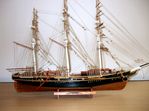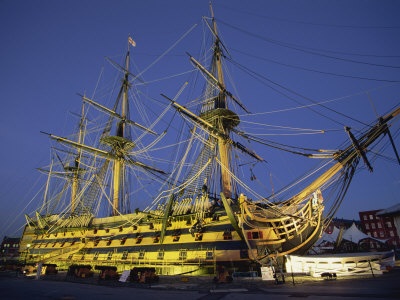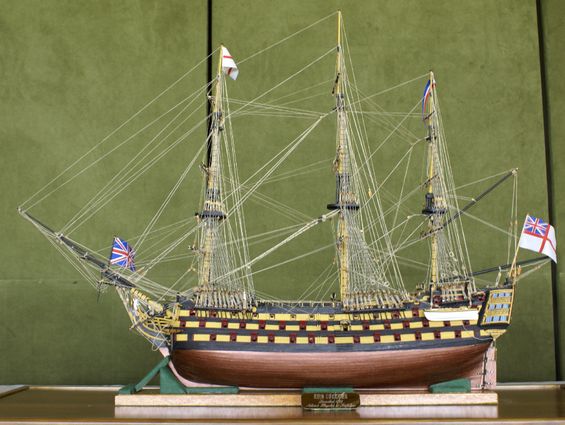Classic Model Ships 24/1
PROFILE AND HISTORY
HMS "Victory" at Portsmouth
HMS "VICTORY"
1765 to the present day
A History and Profile
The colonial expansion of Britain during the 18th century required a substantial expansion of the naval fleet. Naval battles during the period resulted in the depletion of men-of-war and in 1758
the government decided to an increase of twelve 'ships of the line'. Heading the list was a 'first rate' vessel of 100 guns, the largest ever built for the navy. She was to become the fifth vessel named "Victory". Her keel was laid in the Chatham drydock on
23rd July 1759 and she was launched on 7th May 1765 having cost 63,176 pounds. The sum equates in modern terms to the ordering of an aircraft carrier. It is said a whole forest of oak trees was used in her construction.
Following the 38 years of battles, wherein Britain was under constant threat, she was refitted at Chatham and became the flagship of Admiral Lord Nelson. On May 15th 1803, Nelson embarked, with his supporting vessels, on a mission to totally destroy the French fleet. Having out-manoeuvred the enemy at every encounter through brilliant seamanship, Nelson eventually cornered the combined French and Spanish fleets on the 21st October 1805 outside Cadiz, near the Straits of Gibraltar. The ensuing "Battle of Trafalgar", named after the nearest Cape, resulted in the accomplishment of Nelson's mission but he paid for it with his life.
HMS Victory was preserved by Britain as a tribute to its naval might, the memory of an heroic and talented seafarer and as an on-going inspiration to to-days fleet. Still in commission as the flagship of the Commander in Chief Naval Home Command, she lies in splendour in dry dock in Portsmouth, United Kingdom. Forming part of the Royal Naval Museum, the vessel is open to the public every day of the year except Christmas Day.
SPECIFICATIONS AND DETAILS
Length overall: 227.0 ft Breadth extreme: 52.0 ft Mainmast heightfrom waterline: 205.0 ft
Approx. displacement: 3,500 tons Manning: 850 personnel
Construction: Keel of elm and oak Hull with outer and inner skins of oak two feet thick and with 3,923 pieces of 4'0"x1'0" copper sheeting overlay below waterline.
Armament: Gun Decks 30 x 32 pounders, 24 x 28 pounders, 30 x 12 pounders
Quarter Deck: 12 x 12 pounders
Forecastle: 2 x 68 pound carronades and 2 x 12 pounders
Note: At a range of less than a mile, a 32 pounder shot could penetrate 2 ft of oak.
Rigging: consists of 27 miles of running and standing rigging and was able, under plain sail, to set 4 acres of sail.
HMS "Victory" on display at Parliament House NSW, Australia
HMS "VICTORY"
1765 TO THE PRESENT DAY
THE MODEL
This model is built from a design with plans supplied by the Corel company of Italy. It was commenced in November
2004 and completed in March 2006. It follows closely the design and layout of the actual vessel as it is now seen in Portsmouth. The model took approximately 1200 hrs to complete.
The colour scheme follows the chequerboard style chosen by Admiral Lord Nelson, as was customary at the time, of black and ochre stripes on the hull with matching colours on the masts and yards. The rigging is true to plans but no sails and the associated running rigging are included as the vessel is depicted to be in harbour/drydock, as is the original vessel.
The hull below the waterline is painted in metallic copper to represent the copper sheathing, introduced in 1780 to protect against the toredo worm. The after gallery and the figurehead below the bowsprit have very intricate designs which are hand painted on compressed wood fibre moulds.
The keel and frames are made of plywood, cut and fashioned to shape. The hull planking is double thickness with the outer skin being made of walnut, steam bent and fashioned to shape and size. The deck planking of tanganyika timber is similarly singly laid and fashioned. The internal beams are of beechwood as is the rudder. The cannons are of precast metal as are the gunport lids (mantelets). Some brass fittings are pre made whilst others are shaped from brass wire and flat plate. Five different sizes, types and colours of cottons are used in the rigging which is all individually knotted and lightly glued. There are over 2,000 knots alone in the ratlines.
PARTICULARS OF THE ENCASED MODEL
Scale: 1:98 Length: 1120 mms Breadth: 420 mms Height: 850 mms
The original Corel Kit was provided by Don Burke following his visit to the vessel in Portsmouth. He had been filming the Chelsea Flower Show in 2004 and on his return to Sydney, offered the kit in a competition on his TV show which I was fortunate enough to win. It was an opportune time to make the model in time to commerate the bicentenary of the Battle of Trafalgar iin 2005. The value of memorabilia increased dramatically during that year.
Having undertaken to return the model to Don after construction, on the basis that it would be auctioned for charity, the model duly raised substantial funds at the auction held in the NSW Parliament House in 2006. It was re-auctioned in the following year, and now resides in the Board Room of a Real Estate agent's Head Office in Sydney who bought it outright in the third year.
Seven years
later, I decided to re-write my history books and build another "Victory" but this time a smaller but, just as intricate, a 1:150 model which is now located on this site in in the pages below. It proved to be just as much a challenge as the larger version.


